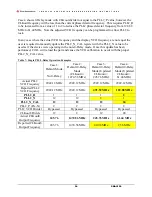
L M K 0 4 9 0 6 E V A L U A T I O N B O A R D O P E R A T I N G I N S T R U C T I O N S
SNAU126
9
5. Visual Confirmation of Frequency Lock
After a default mode is restored and loaded, LED D5 should illuminate when PLL1 and PLL2
are locked to the reference clock applied to CLKin1. This assumes LD_MUX = PLL1/2 DLD
and LD_TYPE = Active High, which are the default settings.
6. Enable Clock Outputs
While the LMK04906B offers programmable clock output buffer formats, the evaluation board
is shipped with preconfigured output terminations to match the default buffer type for each
output. Refer to the CLKout port description in the Evaluation Board Inputs and Outputs section.
To measure phase noise at one of the clock outputs, for example, CLKout0:
1.
Click on the
Clock Outputs
tab,
2.
Uncheck “Powerdown” in the Digital Delay box to enable the channel,
3.
Set the following settings as needed:
a.
Digital Delay value
b.
Clock Divider value
c.
Analog Delay select and Analog Delay value (if not “Bypassed”)
d.
Clock Output type.
4.
Depending on the configured output type, the clock output SMAs can be interfaced to a
test instrument with a single-ended 50-ohm input as follows.
a.
For LVDS:
i.
A balun (like ADT2-1T) is recommended for differential-to-single-ended
conversion.
b.
For LVPECL:
i.
A balun can be used, or
ii.
One side of the LVPECL signal can be terminated with a 50-ohm load and
the other side can be run single-ended to the instrument.
c.
For LVCMOS:
i.
There are two single-ended outputs,
CLKoutX and CLKoutX*, and each
output can be set to Normal, Inverted, or
Off. There are nine (9) combinations of
LVCMOS modes in the Clock Output list.
ii.
One side of the LVCMOS signal can be
terminated with a 50-ohm load and the
other side can be run single-ended to the
instrument.
iii.
A balun may also be used. Ensure
CLKoutX and CLKoutX* states are
complementary to each other, i.e.:
Figure 7: Setting LVCMOS modes
Figure 6: Setting Digital Delay, Clock Divider, Analog Delay, and Output Format for CLKout0









































